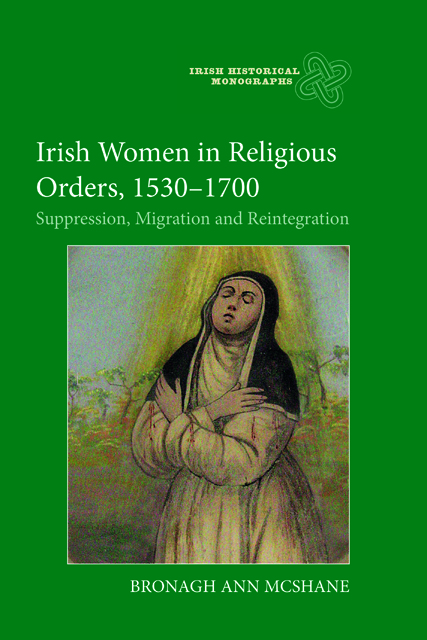5 - Reintegration and renewal: female religious communities in Ireland, 1629–49
Published online by Cambridge University Press: 17 December 2022
Summary
An informal suspension of measures against Catholic practice in Ireland from 1619 onwards set the 1620s and 1630s apart from preceding decades in terms of religious toleration. The international climate, with war looming between the English crown and Spain (and later France), placed a priority upon the security of Ireland resulting in the granting of a series of concessions to Catholics in Ireland in return for financial contributions towards the war effort. These concessions (known as ‘the Graces’) were granted by King Charles I in May 1628 and served to bolster Catholic confidence in prospects for greater religious toleration. This development provided the context for a remarkable flowering of Catholicism during the period. Although there continued to be intermittent spells of repression, the prevailing environment of Catholic resurgence from the 1620s onwards allowed male religious orders in Ireland to aspire to a more stable existence than was hitherto possible. Thus, communities of male religious were established or re-established in towns and cities across the island. In Dublin, Catholic resurgence was particularly pronounced. In March 1629, one Dublin Castle official, Sir John Bingley (d. 1638), complained that there were 14 mass-houses in the city, catered for by various religious orders, among them Dominicans, Franciscans, and Carmelites. In addition, there were allegedly 80 Jesuit priests resident in the metropolis where at their residence they ‘adorned their altars … with images and other idolatrous popish trash as fully as in Rome if not more’.
The Jesuit residence referred to by Bingley was Kildare Hall, a newly established seminary located in the heart of Dublin city and financed by Elizabeth Fitzgerald, née Nugent (d. 1645), countess dowager of Kildare, primary benefactor of the Jesuit order in Ireland during the first half of the seventeenth century. Established in 1628 at Back Lane on property the countess leased ‘from the chapter of Christ Church Cathedral for forty years for a rent of £12 per annum’, the building complex was vast and included a ‘college, a novitiate, a sodality, the main chapel (called Kildare Hall), and the countess of Kildare’s private residence’.
- Type
- Chapter
- Information
- Irish Women in Religious Orders, 1530-1700Suppression, Migration and Reintegration, pp. 163 - 199Publisher: Boydell & BrewerPrint publication year: 2022

